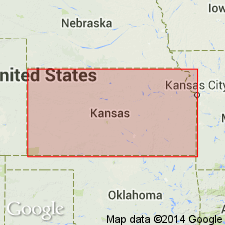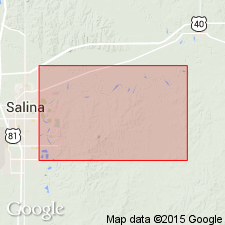
- Usage in publication:
-
- Greeley gypsum
- Modifications:
-
- Original reference
- Dominant lithology:
-
- Gypsum
- AAPG geologic province:
-
- Salina basin
Summary:
Pg. 10. Greeley gypsum. A gypsum bed in Geuda salt measures, about 100 feet higher stratigraphically than Hope gypsum. Age is Permian.
Named from Greeley Twp., Saline Co., central KS.
[See also "Modern classifications of the Permian rocks of Kansas and Nebraska," compiled by M.G. Wilmarth, Secretary of Committee on Geologic Names, USGS unpub. corr. chart, Oct. 1936, 1 sheet.]
Source: US geologic names lexicon (USGS Bull. 896, p. 866).

- Usage in publication:
-
- Greeley gypsum
- Modifications:
-
- Areal extent
- Dominant lithology:
-
- Gypsum
- AAPG geologic province:
-
- Salina basin
Summary:
Pg. 58-61. Greeley gypsum. Gives further description of this gypsum bed. Age is Permian.
[See also "Modern classifications of the Permian rocks of Kansas and Nebraska," compiled by M.G. Wilmarth, Secretary of Committee on Geologic Names, USGS unpub. corr. chart, Oct. 1936, 1 sheet.]
Source: US geologic names lexicon (USGS Bull. 896, p. 866).
For more information, please contact Nancy Stamm, Geologic Names Committee Secretary.
Asterisk (*) indicates published by U.S. Geological Survey authors.
"No current usage" (†) implies that a name has been abandoned or has fallen into disuse. Former usage and, if known, replacement name given in parentheses ( ).
Slash (/) indicates name conflicts with nomenclatural guidelines (CSN, 1933; ACSN, 1961, 1970; NACSN, 1983, 2005, 2021). May be explained within brackets ([ ]).

